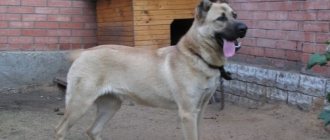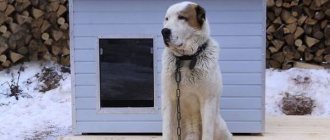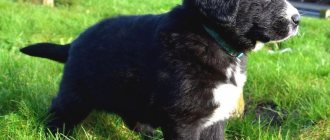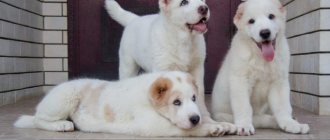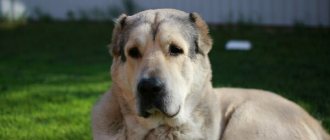Alabai or Central Asian Shepherd is a breed of dog with developed intelligence and a specific character. By adhering to the rules in raising a pet, the owner will raise a faithful friend. Raising and training the Alabai are two different processes. The first is aimed at acquiring social qualities, the second is training in special skills, for example, security.
Alabai training: features of training
Features of raising an Alabai puppy
Dog training begins from the moment it appears in the family. You can read more about the breed itself, its characteristics and history, and caring for the Alabai in a special article on our website. Puppies are sold at two months old. At this age they respond well to education. There are features of animal socialization that you need to pay attention to:
- The Alabai puppy needs to be immediately made clear who the “leader” is, otherwise he will feel like he’s in charge.
- The pet builds a hierarchy. The main thing is the owner. It is important to show the role of household members so that the “Asian” does not feel second to the “leader”. Such dogs, who have not received proper training, growl at children and old people. This is how their intellect works, they consider themselves more important.
- From the first days the puppy is taught to be prohibited. The skill is important, but it is important not to overdo it so that the dog does not grow up too cautious.
Already as a puppy, Alabai should clearly learn the word “No”
- You definitely need to play with the baby, but at the same time clearly delimit the time for games, education, and feeding.
- You can’t be too gentle with a small Alabai. The owner must be persistent.
- The puppy should not be beaten, otherwise the older dog will become aggressive and stop obeying.
- It is better to choose an enclosure for your pet. The Central Asian Shepherd is not a chain dog or a lap dog.
An open-air enclosure is preferable to four walls, in which the Alabai will be cramped
If you decide to make an enclosure for an alabai with your own hands, then below is a brief step-by-step construction instruction.
Do-it-yourself aviary for Alabai
It is necessary to decide what qualities the owner wants to cultivate in the pet even before its appearance. Training a security guard is different from training a companion dog. Be sure to take into account the puppy’s natural characteristics and his type of temperament. A naturally evil animal will not become a good friend for an elderly person.
Command training
Any education must be consistent and consistent. When training an Alabai, you must adhere to certain rules and train the puppy systematically and regularly.
You cannot move on to learning the next command until the previous one has been mastered.
To me
The team is one of the first to be taught. Say “Come to me!” and show the Alabai a treat. As soon as he approaches, praise your pet.
Near
During a walk, the dog walks on the left side of the owner. Its withers are at the level of a person's leg. This can be achieved with the help of a leash. Say “Near!” and lightly pull the leash until the Central Asian Shepherd is in the desired position. Praise him.
It is important! When forced to carry out commands, the alabai can only cause slight inconvenience, but not pain. Therefore, you don't need to pull the leash too hard.
Voice
During training, show the dog a treat and raise your hand high. Do not give away food until the pet starts barking out of impatience and frustration. Say “Voice!” and encourage the baby. The easiest way to teach a child is next to a dog that already knows how to give “Voice!”
Alabai will understand why his brother is being encouraged, and will immediately begin to repeat what he saw in the hope of a treat.
Sit
Take the treat in your hand and raise it above the dog's face. Say “Sit!” and lightly press on the sacrum with your second hand. Then give the treat.
Stand
When the puppy is lying or sitting, say “Stop!” and put the baby on his paws, lifting him by the tummy. Give a treat.
Go for a walk
A long leash is used for training. Say “Walk!” and start walking around the area, moving away to a great distance. Looking at the owner, the alabai will begin to walk around and explore the surrounding area.
Place
Alabai should sleep only on his own bedding. As soon as the baby starts to fall asleep, say “Place!” and take it to the litter. You can reinforce the command with treats. Go to the bedding, say “Place” once and show your pet a treat. Reward the dog when he approaches.
Lie
When an Asian is sitting, say “Lie down!” and lower your hand with the treat to the ground. Lightly press on the withers of the Alabai so that it lies down completely. Encourage the dog.
It is forbidden
They teach the command on the street. When your dog does something inappropriate, say “No” and pull the leash.
Ugh!
As soon as the Alabai reaches for something on the ground, say “Fu!” and pull the leash. If your pet has already picked something up, say “Ugh!” and take this thing away.
Important! Teams "Fu!" and "Don't" have the same meaning. They teach one of the commands so that the dog does not get confused.
How do they start raising Alabai?
A two-month-old puppy that looks like a bear cub evokes affection and a desire to cuddle and play. But already at this age you need to lay the foundations for a comfortable life with an adult dog. Socialization of an Asian begins with determining the feeding regime. Based on it, time is set for games, walks, and training. At the same time, the puppy is accustomed to a leash, collar and enclosure.
Following a clear schedule in feeding, playing and training will allow you to discipline the Alabai from childhood
The next important point is establishing contact. Until two months old, the baby lived with his mother; she was his leader. After the Alabai enters the family, the owner must assert his authority. This begins before 6 months of age; later the process becomes more complicated. How does this happen? Nature dictates that a puppy follows a large moving object. The owner takes him outside, lets go of the leash and leaves. The pet runs after him, the man crouches, strokes and praises the dog. When danger appears, such as other dogs, the owner protects the puppy. The baby accepts the authority of the one with whom he feels safe.
It is important for a puppy to feel in the owner the same protector as his mother was.
These walks are done every day. Over time they become longer. When your pet gets used to the area, you can change direction.
The next stage is the development of unconditional submission. The dog must be obedient in all circumstances. The “Asian” senses the owner’s mood by the intonation of speech. Dissatisfaction and the desire to rein in the pet should sound stern. The words must contain the sound “r”. Shouting has no effect on a balanced Alabai, since the dog does not understand what is happening. Unconditional obedience is important to develop before the age of 9 months.
A nine-month-old alabai is already indistinguishable from an adult, and an appropriate approach to it is required
Recommendations from dog handlers
Be consistent during education and training. Don't jump from learning one skill to another. Do not give the alabai a command that he cannot execute for some reason. It is imperative to ensure that the dog does what is required.
The command should only be spoken once and not repeated over and over again. Encouragement can only be given if the dog has earned praise for his actions.
At first, the Alabai should be trained in a familiar environment: at home or during daily walks. Next, the pet must be taken to unfamiliar places and achieved obedience under any conditions.
Alabai is a large and proud dog, which is distinguished by its independence and the ability to make its own decisions. This fact complicates upbringing and training, because the dog will only listen to someone who has authority for him.
When the owner is not confident in his abilities, it is better to involve a professional in raising and training the pet. This will help avoid many problems, because a large, ill-mannered dog can injure and even kill a person.
The main stages of raising an Alabai puppy
Table 1. Raising Alabai in the first months
| Action | Details |
| Accustoming to a nickname | The process begins after contact is established. The nickname is used to call the puppy for feeding or playing. The name is spoken while stroking. It is important to form positive associations with the nickname. At the moment when the puppy needs to be tamed, the nickname is not used |
| Meet the “Come to me!” team | The command is pronounced simultaneously with the nickname in a calm voice. Later the words “Come to me!” help identify hosts. For following the command, the puppy is petted and given a treat. If the pet is in no hurry to approach, the owner needs to sit down or run away. Such actions arouse interest or a desire to run after. When the puppy finally runs up, you need to praise him |
| Learning to go to a place on command | While the puppy is small, the command “Place!” use it so that it does not interfere. A rug is provided for the puppy. They take the pet to this bedding and say “Place.” Next, on command, the “Asian” must lie down or sit on this mat. The puppy is rewarded for obedience with a treat. If the dog is not taught a place in time, it will choose it on its own and then it will have to be retrained |
| Teaching the command “Fu!” | It is common for a puppy to pick up objects on the street that can harm him. To prevent this from happening, he must navigate when this cannot be done. They master the command at home. If the puppy takes a prohibited object in its teeth, they pronounce a command and take it away. If the pet takes this item again, the command “Fu!” They give it more strictly and press on the dog’s sacrum. As soon as the command is completed, remove the hand from the sacrum, praise and encourage the alabai |
| Teaching the “No!” command | A command means a ban on a particular action. Completion is achieved through repeated repetitions. |
A puppy that has mastered the above actions is easier to train and learn the commands: “Lie down!” , "Sit!" , “Voice!”, “Quiet!”, “Nearby!”, “Forward!”.
Manipulations with food are effective at all stages of education. Actions help to form the desired model of dog behavior. The character of a pet is formed from 9 months to 3 years.
Remember that treats should be handled carefully, otherwise the puppy will quickly get fed up
The dog is not fed in a noisy place; a place for the bowl is allocated in a secluded corner. With the help of food, all family members establish contact with the pet. Exercises with a bowl train endurance. Before serving food, the owner makes sure the puppy sits down and waits. If he begins to jump impatiently, then the bowl is demonstratively taken away. When the puppy sits down, immediately give him a bowl of food.
It is acceptable to make changes to the pronunciation of commands if you are not preparing your pet for a show.
If the dog is raised only for itself, then you can use other words to indicate commands. Common expressions are needed to pass the standards.
Important points in education
- Alabais are excellent guards; these qualities are in their blood. A young dog may exhibit them in an inappropriate situation (for example, growling at others in a crowded place, preventing household members from entering the owner’s house or room). Such manifestations in a puppy must be suppressed. As an adult, it is difficult to cope with such behavior.
Alabais show themselves as guardians almost from the cradle
- To maintain authority, the owner should enter the gate or door first, then let the dog in.
- An Alabai puppy is taken for a walk on a leash, even if it is still small and is not capable of causing harm to others. An adult dog is not allowed out without a muzzle.
Wearing a muzzle outside the home is essential for such a strong and willful breed.
- The Central Asian Shepherd can think, so it must always understand why it is following a command. At first it’s praise and treats.
- Alabai is not taught the “Fetch!” command. This breed does not have the reflex to fetch an abandoned item.
Video - Basics of training an Alabai puppy
Character and temperament
Alabais are balanced, calm and phlegmatic. These character traits are manifested in Central Asian Shepherd Dogs, which have received enough time for their education and training.
You need to start training Central Asian Shepherds early: while the dog is small, he has not yet begun to think about dominance.
The owner must achieve complete obedience of the puppy, then the adult dog will be a faithful family friend and will get along well with other pets.
Alabais are indifferent to strangers during walks, but they will defend their territory from strangers. This breed is perfect for guarding. However, for these purposes the dog must undergo a special course of education and training.
The Central Asian Shepherd cannot be kept in an apartment or on a chain. The dog definitely needs a free enclosure.
This is interesting! Alabais do not learn the “Fetch!” command well. They don't like to bring in abandoned items.
Differences in the upbringing of males and females
Little stubborn people at first refuse to follow commands and obey the rules. This applies to dogs of both sexes. Males quickly recognize the leadership of their owner. After several attempts at disobedience and evasion of orders, the males obey.
Despite their straightforward nature, Alabais can be cunning and evade commands.
Females take longer to learn obedience. The “Asian” first snaps, then realizes that it is useless and begins to be cunning. By avoiding following the command, the dog pretends to be weak and sick. When the female understands that the owner has taken pity on her and no longer demands submission, she again becomes cheerful and playful. With bitches, the owner needs to show even more patience and perseverance.
Education from 2 months
Most often, puppies are separated from their mother at the age of 2 months, and they go to their owners. From this moment it is necessary to begin training.
Important! When rehoming a puppy, it is advisable to take an item from its old habitat. The smell of his mother will help him get used to the new place and cope with stress.
The main rule when raising an Alabai is restraint. Representatives of this breed perceive sharp sounds and movements as weakness on the part of a person, and therefore will not respect him. If it is necessary to punish an animal, you should not resort to hitting and screaming; a sufficient measure would be to say “No!” or “Ugh!” and shake it a little by the scruff of the neck.
Learning commands should be carried out sequentially, because understanding them takes Alabais much longer than other breeds. But when the dog masters certain commands, he will subsequently carry them out flawlessly. The owner should be patient and devote as much time as possible to their pet.
The dog must firmly understand that all commands, without exception, must be followed. Feeling the slightest relaxation in his direction, the alabai will begin to be mischievous and allow himself to disobey. During training, the dog should feel confident and calm in its owner.
Reference! Alabais are characterized by slow maturation. Until the age of three, a dog is considered underdeveloped. That is why the first matings occur later than in other breeds.
How to raise an adult dog?
An adult Alabai ends up in a new family when it loses its previous owners. An enclosure will be immediately organized for him. In addition, the yard must be surrounded by a strong fence to prevent the new 80-pound resident from escaping.
First one of the household members establishes contact. To do this, he goes out into the yard and lets the dog out. The person must behave as if he does not notice the dog, while furtively observing him. The dog's attempts to take a step towards the new owner should be met with an approving look.
Getting to know the Alabai should not be accompanied by tenderness - the dog should be given time to look around
Female shepherd dogs get used to a new home and environment faster than males. It is considered normal behavior if at first the dog refuses food and does not allow petting or wearing a collar. During the adaptation process, you cannot use brute force: pull the leash, put on a strict collar. Also, do not insist on eating food. All these actions lead to the animal’s aggression and do not contribute to establishing contact.
If the Alabai is handled correctly, it will treat household members kindly and calmly
An adult Alabai is taken outside the yard after it has adapted to a collar and leash. To prove himself as a leader, the owner takes the dog with him to unfamiliar places. Until this moment, the dog is allowed out of the enclosure for a walk around the yard.
Where to start training
If a puppy was born in an enclosure, it can be moved outside immediately after moving. The only condition is that the weather is not too cold.
If the Alabai lived in an apartment, after purchase the baby should be kept indoors. Your pet needs to be accustomed to the enclosure gradually.
Alabai should be trained in a quiet place where there are few distractions.
Remember the nickname
At the beginning of training, the Central Asian Shepherd must learn its name. You should not call your puppy different pet names, because it will be more difficult for him to get used to the nickname.
The baby must be called by name, and when he responds, encourage him. The nickname is pronounced along with the commands.
Toilet training a puppy
For toilet training, you should use special diapers or newspapers. They need to be spread on all places where the puppy relieves himself.
As soon as the Alabai goes to the toilet for diapers, the baby needs to be praised and encouraged. Over time, the number of diapers is reduced until one remains in the most suitable location.
To toilet train an Asian on the street, you will have to walk him several times a day: after eating, sleeping and playing. You can take a dirty diaper with you. When the baby relieves himself on the street, he is praised.
It is important! You can take Alabai outside only after he has received his first two vaccinations.
Behavior on the street
From the very beginning of training, the owner must show his authority in front of the pet. Central Asian Shepherds can feel a little confused in unfamiliar places. The puppy should be taken for a walk along a new route each time.
The confused baby will follow the owner and accept him as a leader. In case of aggression from another dog, the puppy must be protected, just as the mother does. This way you can build trust.
Until six months, the Alabai should be taken outside on a harness. Afterwards you can use a collar and leash. This is a large dog, so the Asian must be muzzled.
It is better to walk in uncrowded places, away from other dogs.
Outdoor training
Some activities need to be done outside:
- Practicing the commands “Ugh!” and “Come to me!” The dog must follow these two basic commands regardless of the circumstances. Alabai is taught to obey commands and not pay attention to external irritants (cats, birds, other dogs).
It is necessary to train the Alabai to hear and notice the owner even in the presence of distractions
- Teaching the command “Road!” With this word, the owner stops the dog in front of the roadway or just a moving car. The command is spoken and insisted on being carried out, even if the road is clear of traffic.
- Executing the command “Barrier!” occurs on the street, since the dog’s size will not allow it to jump over obstacles at home.
- Training to climb stairs.
- Swimming. Alabai are accustomed to water carefully; not all individuals like to swim. The habit is formed gradually, each time taking the shepherd dog a little deeper. This skill is optional, so there is no need to insist on learning.
What needs to be vaccinated first?
An emotional connection with the owner is established immediately and unquestioningly. The first thing to consider is that only the owner is allowed to pet, feed or encourage the puppy. The dog should not have any contact with strangers, even family members, until the owner is recognized as a puppy.
The first commands that a puppy must carry out flawlessly in the first six months of life are the commands: “Near!”, “Stand!”, “No!”, “Place!”, “Come to me!”, “Teeth!”. The puppy must calmly accept and wear the muzzle.
Training methods and scheme
The training process should follow the following pattern: command – praise – treat. During one puppy training session, the scheme is repeated no more than three times. The baby gets tired quickly. New commands are added only after mastering and unquestioning execution of those already learned.
Proper distribution of training hours will avoid overworking the puppy
Traditionally, the following training methods are distinguished:
- encouragement;
- prohibition;
- compulsion.
Table 2. Methods of training Alabai
| Method | Details |
| Promotion | It has two manifestations: praise and treats. It is important to dose encouragement correctly in order to indicate the pet’s growth zone, without depriving him of motivation with too frequent “compliments” |
| Prohibition | Assumes strict systematicity and lack of ambiguity. It should not be allowed that the same action is sometimes permitted and sometimes not. There is no need to introduce unreasonable bans; the dog should not be afraid to take the initiative. |
| Compulsion | The tools of the method are a strict tone, shaking, pressing on the sacrum, pulling on the leash. The unpleasant sensations from these actions stimulate the animal's submission. Physical pain should not be caused to a dog during training. |
How to stop biting?
The dog must clearly perceive the owner’s mood in order to understand what is bad and what is good.
If during play the puppy begins to bite, it should be stopped immediately, so the bite will be a signal for the end of the fun.
Also use a stern voice intonation, almost a growl. Thanks to this, the dog will understand how the owner is determined and that the action needs to be stopped. In order to stop biting, strong clicks on the nose are suggested.
Important! Alabai puppies must be taught to sharpen their claws from an early age, so you should immediately purchase special nail clippers.
Special training of Alabai
The owner teaches the alabai how to carry out basic and subsequent commands. For special training of given qualities, it is better to contact a specialist.
Training Alabai to work in the pasture
Puppy training begins at 1.5 - 2 months. These dogs take long walks of 2–3 hours. After the Alabai has mastered commands and obedience, he is taught to hurry up animals that are lagging behind or that are far away.
Alabai has shepherd skills in his blood, so learning this craft comes easily to him
The dog handler attaches a 11-13 meter leash to the shepherd dog and walks with her to the lagging animal. Then he says the command “Drive!”, while cracking the whip and pointing in the desired direction. The trainer completely loosens the leash. The dog runs towards the herd, the man moves with it, at the same time praises it, saying: “Okay, drive, good.” The rut is stopped with the command “Come to me!” After achieving the goal, the alabai is given a treat. Success is achieved by repeating the procedure many times. Then the training continues without a leash.
Although the Alabai does not tend to show aggression towards the herd, sometimes a muzzle is required to prevent bites
If a dog without a leash becomes distracted, does not follow commands, or grabs livestock by the legs, the training begins again with a leash.
First, they are taught to hurry up animals that are 10 to 30 meters behind, then at longer distances. If the Alabai is aggressive in nature, then training is carried out with a muzzle and a strict collar.
To control the movement of the herd, the alabai is directed in the direction opposite to the one in which it is necessary to turn. At the command “Drive!” The shepherd runs after the cattle, which have gone a little further than the rest. The animals turn in the right direction, the herd follows them. As soon as the goal is achieved, the shepherd commands “Come to me!”
It is enough to teach the Alabai the basics of driving livestock so that he quickly gains confidence and independence
The rotation of the herd in the desired direction is also regulated by the location of the alabai in front of the herd. The cattle, having reached the shepherd, will turn in the right direction. Such herd management requires considerable endurance from the Alabai. Team "Voice!" used if the herd comes too close to the dog, but does not go in the right direction. A trained Central Asian Shepherd is capable of independently making decisions about catching animals that are lagging behind or wandering to the side, and about turning the herd in the right direction.
Training Alabai for protection
The shepherd dog is taught to guard the house from the age of six months. This skill requires a professional approach. The trainer teaches the dog:
- distrust strangers and bark at them;
- pursue the intruder;
- protect the owner;
- protect the territory and specified objects;
- take a trail, find people and objects.
Only a specialist can develop hunting skills in Alabai
It is important to find a dog handler who has experience working specifically with Alabai. The peculiarity of the breed is that when practicing the skills of defense and attack and the lack of the right approach, the shepherd dog will not grab onto the protected hand, but into the open throat. At the same time, the future security guard is dealt with individually. In a group with other dogs, the Alabai shows aggression and becomes uncontrollable.
When to start training
Raising and training a baby Alabai begins as soon as he moves to a new home. This usually happens when the puppy is 2 months old.
The baby must be taught strict discipline from the very beginning. At the same time, not only the owner should be an authority for the alabai, but also all family members.
If the dog considers himself a second member of the pack after the leader, he will begin to show aggression towards other members of the household.
Training scheme
Alabai is one of the breeds that takes a long time to grow. A dog is considered fully grown and mature at the age of 3 years.
All basic commands are taught to the puppy before the age of 5 months. From six months you can start working with a dog trainer to develop working skills. Full obedience is taught up to 9 months.
When he has mastered all the basic skills, classes should be repeated periodically.
The first days in a new home - important rules
So, the miracle happened and you brought your fluffy little ball home. Despite the flurry of positive emotions, it is important to help the baby adapt . We talked above about a piece of bedding with the mother’s scent; in addition, try not to leave the baby alone for a long time.
Raising an Alabai puppy will begin from day one, whether you realize it or not. The “pros” have different opinions about whether you should allow your baby to sleep next to your bed. Subjectively, it is better to support the puppy by reducing stress and teaching him to sleep in place gradually. However, you should not pamper your pet, allow him to climb on furniture or pick him up. If the puppy asks to sit on your lap, it is better to sit on the floor and let him sniff your face. For many dogs this ritual is very important.
Basic rules and advice from a dog handler
Training an Alabai is impossible without establishing psychological contact between the owner and the dog. The pet must trust you, and only then can you teach it to perform various commands. When training your dog, try not to overdo it: hitting your pet or yelling at it is not the best option. It’s better to carefully grab the puppy by the withers, shake it and say “Ugh!” or “You can’t!” Pay special attention to your facial expressions, as well as the intonation of your voice (you can raise it or speak to the dog in a serious, low voice). This way your four-legged friend will learn to take your words seriously. Screaming will not bring any results.
When an Alabai boy or girl is 6–7 months old, the first results are evident: the pet must know and follow basic commands, walk down the street in a muzzle, and also calmly respond to the owner’s touches and caresses. Another important point that experts recommend paying special attention to is that you need to teach the puppy that the owner can take away his bowl. This is necessary so that in the future the pet does not defend its food, since feeding an adult dog can turn into a serious problem for you.
Relocation of Alabai to an enclosure
Depending on the conditions in which the puppy was before its acquisition, it is moved to an enclosure. If he lived on the street with his mother and other puppies, you can immediately place him in an enclosure. If the puppy was born and raised in apartment conditions, it can be moved at 3–4 months. Weather conditions should be taken into account; at -20° it is better to take the dog home.
